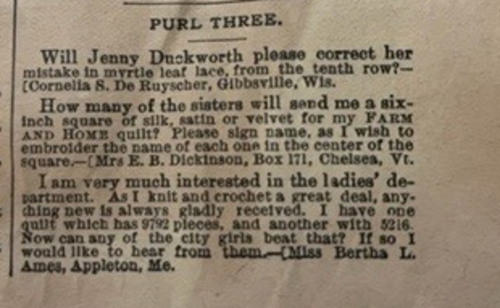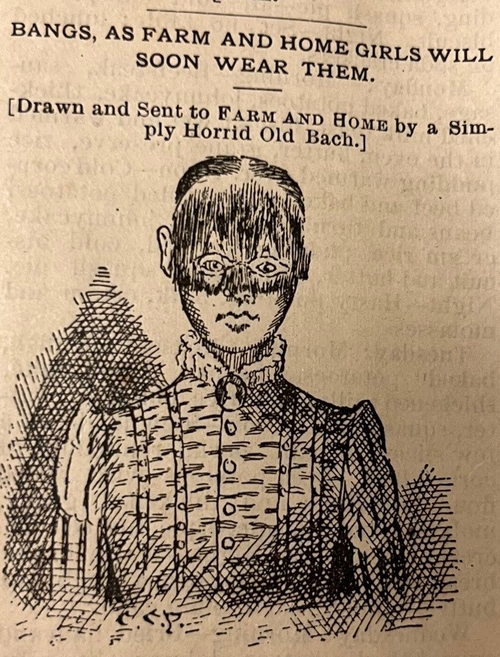Dana Porter Library, first floor
University of Waterloo Library
Waterloo, Ontario N2L 3G1
519-888-4567 x42619 or x42445
Hello everyone! My name is Tenille and this summer I am working as the Srivastava intern co-op student at Special Collections & Archives (SCA).
Although we are slowly but surely working our way back to some sense of pre-Pandemic “normality” (however that might look for you), these pandemic years have left an indelible mark on each of us. For many, like myself, those long periods of forced solitude and isolation were a time of self-reflection and anxiety. They were also an opportunity to try out new things and pick up new hobbies. For me, that hobby was knitting.
Coming from a long line of knitters and crocheters it is patently absurd that I had to pick up this hobby on my own, but that is beside the point! I started my knitting journey with, quite possibly, the world’s ugliest and longest scarf. I have since moved on to more aesthetically pleasing projects. But the biggest impact has not been the growing collection of knitwear in my closet, but rather my desire to talk to others about my hobby. To find others who enjoy this craft as much as I do and pick their brains about patterns or problems, and to encourage friends to try it out and see if they might love it too.
Turns out I was not alone.
There has been much interest among certain scholarly circles about the knitting renaissance, and the rise of modern knitting practices. Craftwork such as knitting has grown in popularity since the early 2000s. With the creation knitting circles, blogs, and forums such as Ravelry, this apparently private and solitary task seems to have been made increasingly public. While this may seem like a modern innovation to an ancient practice, I made an interesting discovery while exploring the stacks. In 2016 SCA received a donation of two knitting scrapbooks (GA441). One of these is a collection of patterns cut from Farm and Home magazine, dated 1890. Interspersed within these patterns are conversations, debates, questions, and suggestions. As seen in the attached photograph, one conversational interlude came in the form of Cornelia S. De Ruyscher, calling for Jenny Duckworth to “please correct her mistake in [the] myrtle leaf lace” pattern.

This image is a section from page 5 of the scrapbook, dated May 15. This is just one example of readers seeking clarification of corrections to patterns provided in the Farm and Home magazine. The bottom comment by Miss Bertha L. Ames is also noteworthy as she seeks “anything new” and challenges other readers to a friendly competition. [GA441-2]
While the internet has reshaped how the conversation takes place, it is clear that knitters have long embraced the social aspect of textile handicrafts. Thriving communities and information networks have existed around the arts for centuries, and knitting is no exception. Using the means available to them, and possibly waiting weeks for a response, these early knitters helped and challenged each other, while also raising other relevant issues. These included debates about women’s right to vote and pros and cons a wearing your hair in bangs (a surprisingly heated debate if the attached drawing is anything to go by!).

This image was taken from page 14 of the scrapbook. The text above states that it was “Drawn and sent to Farm and Home by a Simply Horrid Old Bach.” This appears to be a response to an earlier conversation (page 11 of the scrapbook) of how bangs “make the girls look more intellectual.” [GA441-2]
This is very similar to the practice of “stitch ‘n bitch” circles where the goal is both knitting and social interaction. Again, although this may seem like a modern innovation, it is not the case. This term has been used to describe social knitting circles since the end of World War II (for more information check out Stitch 'n Bitch - Wikipedia). Knitting, it would appear, has not been a solitary activity for quite some time! Far from altering the practice of knitting, modern knitters are simply the next link in a long, interconnected chain.
One thing that has changed since these scrapbooks were created is how patterns are designed and phrased. Unlike modern knitting patterns, or even the Lux Knitting books (a collection in the SCA of workbooks between 1938 to 1958), these Farm and Home patterns are not designed with new knitters in mind. Knitting was such a fundamental skill that the patterns in this 1890 scrapbook were created with the assumption that readers would understand the directions, abbreviations, and terminology without further explanation. While these patterns may be best suited to a more experienced knitter, I am nevertheless excited to give it a shot and hopefully share my journey with others.




